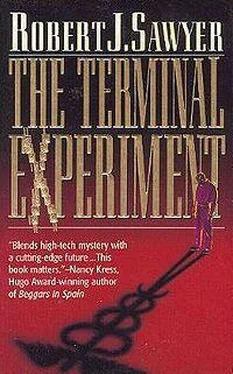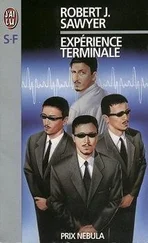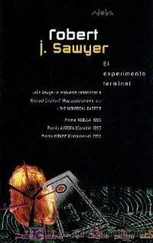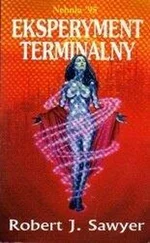Robert Sawyer - The Terminal Experiment
Здесь есть возможность читать онлайн «Robert Sawyer - The Terminal Experiment» весь текст электронной книги совершенно бесплатно (целиком полную версию без сокращений). В некоторых случаях можно слушать аудио, скачать через торрент в формате fb2 и присутствует краткое содержание. Год выпуска: 1995, ISBN: 1995, Издательство: Harper Prism, Жанр: Фантастика и фэнтези, на английском языке. Описание произведения, (предисловие) а так же отзывы посетителей доступны на портале библиотеки ЛибКат.
- Название:The Terminal Experiment
- Автор:
- Издательство:Harper Prism
- Жанр:
- Год:1995
- ISBN:0-06-105310-4
- Рейтинг книги:5 / 5. Голосов: 1
-
Избранное:Добавить в избранное
- Отзывы:
-
Ваша оценка:
- 100
- 1
- 2
- 3
- 4
- 5
The Terminal Experiment: краткое содержание, описание и аннотация
Предлагаем к чтению аннотацию, описание, краткое содержание или предисловие (зависит от того, что написал сам автор книги «The Terminal Experiment»). Если вы не нашли необходимую информацию о книге — напишите в комментариях, мы постараемся отыскать её.
magazine in the mid-December 1994 to March 1995 issues, under the name
, before its first novel publication in May, 1995.
Won Nebula Award for Best Novel in 1995.
Nominated for Hugo Award for Best Novel in 1996.
The Terminal Experiment — читать онлайн бесплатно полную книгу (весь текст) целиком
Ниже представлен текст книги, разбитый по страницам. Система сохранения места последней прочитанной страницы, позволяет с удобством читать онлайн бесплатно книгу «The Terminal Experiment», без необходимости каждый раз заново искать на чём Вы остановились. Поставьте закладку, и сможете в любой момент перейти на страницу, на которой закончили чтение.
Интервал:
Закладка:
The other recording, though, had to be made somewhere else, lest critics charge that the soulwave, far from being a universal component of human existence, was simply some mundane electrical phenomenon related to the wiring in that particular building, or to its proximity to power lines, or to some particular course of treatment used at Carlson’s. So, to get his third recording, Peter had put an ad out on the net:
Wanted: person in very late stages of terminal illness or injury to participate in testing a new biomedical monitoring device. Location: southern Ontario. Will pay participant CDN$10,000. Terminal individuals, or persons with power of attorney for same, please apply in confidence to Hobson Monitoring (net: HOBMON).
Peter felt funny about placing the ad — it seemed so cold. Indeed, his embarrassment probably had a lot to do with why he offered such a large fee. But within two days of the ad going out on the net, Peter had fourteen applicants. He chose a boy — just twelve years of age — who was dying of leukemia. He made the choice as much for compassionate reasons as for varying the sample base: the boy’s family had bankrupted themselves coming to Canada from Uganda in hopes of finding a cure for their son. The money would be some small help in paying their hospital bills.
And, feeling upon reflection that the others who had already participated in the study deserved the same compensation, Peter also made a $10,000 payment to the estate of Gustav Reichhold. Since Peggy Fennell had no heirs, he made a donation in her name to the Canadian Diabetes Association. He reasoned that soon researchers around the globe would be scrambling to reproduce his results. It seemed appropriate to establish up front a generous payment for test subjects.
All three recordings looked remarkably similar: a tiny cohesive electrical field departing the body at the precise moment of death. To be on the safe side, Peter had used a different superEEG unit to record the Ugandan boy’s death. The principles were the same, but he used all-new components, some employing different engineering solutions, to make sure that the previous results weren’t due to some glitch in his recording equipment.
Meanwhile, over the course of several weeks, Peter had also used a superEEG on all 119 employees of Hobson Monitoring, without telling any except his most-senior staff what it was actually for. None of his employees were dying, of course, but Peter wanted to be sure that the soulwave did indeed exist in healthy people, and wasn’t just some sort of electrical last gasp produced by an expiring brain.
The soulwave had a distinctive electrical signature. The frequency was very high, well above that of normal electrochemical brain activity, so, even though the voltage was minuscule, it wasn’t washed out in the mass of other signals within the brain. After making some refinements to his equipment, Peter had little trouble isolating it in scans of all his employees’ brains, although he did find it amusing that it took several tries to locate it in the brain of Caleb Martin, his staff lawyer.
Meanwhile, that selfsame Martin had been working his tail off, securing patent protection on all the superEEG components in Canada, the United States, the European Community, Japan, the CIS, and elsewhere. And the Korean manufacturing firm Hobson Monitoring used to actually build its equipment was gearing up a new production line for superEEGs.
Soon it would be time to go public with the existence of the soulwave.
CHAPTER 12
Peter felt like a student again, pulling off a silly fraternity prank involving putting clothing on animals. He made his way over to one of the cows and stroked it gently at the base of the neck. It had been years since Peter had been this close to a cow; he’d grown up in Regina, but still had relatives who owned dairy farms elsewhere in Saskatchewan, and he’d spent parts of his boyhood summers there.
Like all cows, this one had enormous brown eyes and wet nostrils. It seemed unperturbed by Peter touching it, and so, without further ado, he gently strapped the modified scanning helmet onto its loaf-shaped head. The beast mooed at him, but more in apparent surprise than protest. Its breath stank.
“That it, Doc?” asked the foreperson.
Peter looked at the animal again. He felt a little sorry for it. “Yes.”
At this slaughterhouse, cattle were normally stunned with an electrical charge before being killed. But that method would overload Peter’s scanner. So instead this particular cow would be rendered unconscious with carbon dioxide gas, hung, and then have its throat slit for drainage. Peter had seen a lot of surgery over the years, but that cutting had always been to cure. He was surprised at how upsetting he found the killing of the animal. The foreperson invited him to stay for a full tour, including the butchering of a cow, but Peter didn’t have the stomach for it. He simply retrieved the special bovine headgear and his recording equipment, thanked the various people he’d inconvenienced, and headed back to his office.
Peter spent the rest of the day going over the recording, trying various computer-enhancement techniques on the data. The results were always the same. No matter what method he used or how hard he looked, he could find no evidence that cows had souls — nothing of any kind seemed to exit the brain at death. Not too surprising a revelation, he supposed, although he was quickly coming to realize that for every person who would hail him as a genius for his discoveries, there’d be another who’d damn him for them. In this case, the radical animal-rights lobby would surely be upset.
Peter and Cathy had been planning to go to Barberian’s, their favorite steakhouse, for dinner that night. At the last minute, though, Peter canceled their reservation and they went to a vegetarian restaurant instead.
When Peter Hobson had taken a university elective in taxonomy, the two species of chimpanzees had been Pan troglodytes (common chimps) and Pan paniscus (pygmy chimps).
But the split between chimps and humans had occurred just 500,000 generations ago, and they still have 98.4% of their DNA in common. In 1993, a group including evolutionist Richard Dawkins and best-selling science fiction writer Douglas Adams published the Declaration on Great Apes, which urged the adoption of a bill of rights for our simian cousins.
In took thirteen years, but eventually their declaration came to be argued at the UN. An unprecedented resolution was adopted formally reclassifying chimpanzees as members of genus Homo , meaning there were now three extant species of humanity: Homo sapiens , Homo troglodytes , and Homo paniscus . Human rights were divided into two broad categories: those, such as the entitlement to life, liberty, and freedom from torture, that applied to all members of genus Homo , and other rights, such as pursuit of happiness, religious freedom, and ownership of land, that were reserved exclusively to H. sapiens .
Of course, under Homo rights, no one could ever kill a chimp again for experimental purposes — indeed, no one could imprison a chimp in a lab. And many nations had modified their legal definitions of homicide to include the killing of chimps.
Adriaan Kortlandt, the first animal behaviorist to observe wild chimpanzees, once referred to them as “eerie souls in animals’ furs.” But now Peter Hobson was in a position to see how literally Kortlandt’s observation should be taken. The soulwave existed in Homo sapiens . It did not exist in Bos taunts , the common cow. Peter supported the simian-rights movement, but all the good that had been done in the last few years might be undone if it were shown that humans had souls but chimps did not. Still, Peter knew that if he himself did not do the test, someone else eventually would.
Читать дальшеИнтервал:
Закладка:
Похожие книги на «The Terminal Experiment»
Представляем Вашему вниманию похожие книги на «The Terminal Experiment» списком для выбора. Мы отобрали схожую по названию и смыслу литературу в надежде предоставить читателям больше вариантов отыскать новые, интересные, ещё непрочитанные произведения.
Обсуждение, отзывы о книге «The Terminal Experiment» и просто собственные мнения читателей. Оставьте ваши комментарии, напишите, что Вы думаете о произведении, его смысле или главных героях. Укажите что конкретно понравилось, а что нет, и почему Вы так считаете.








